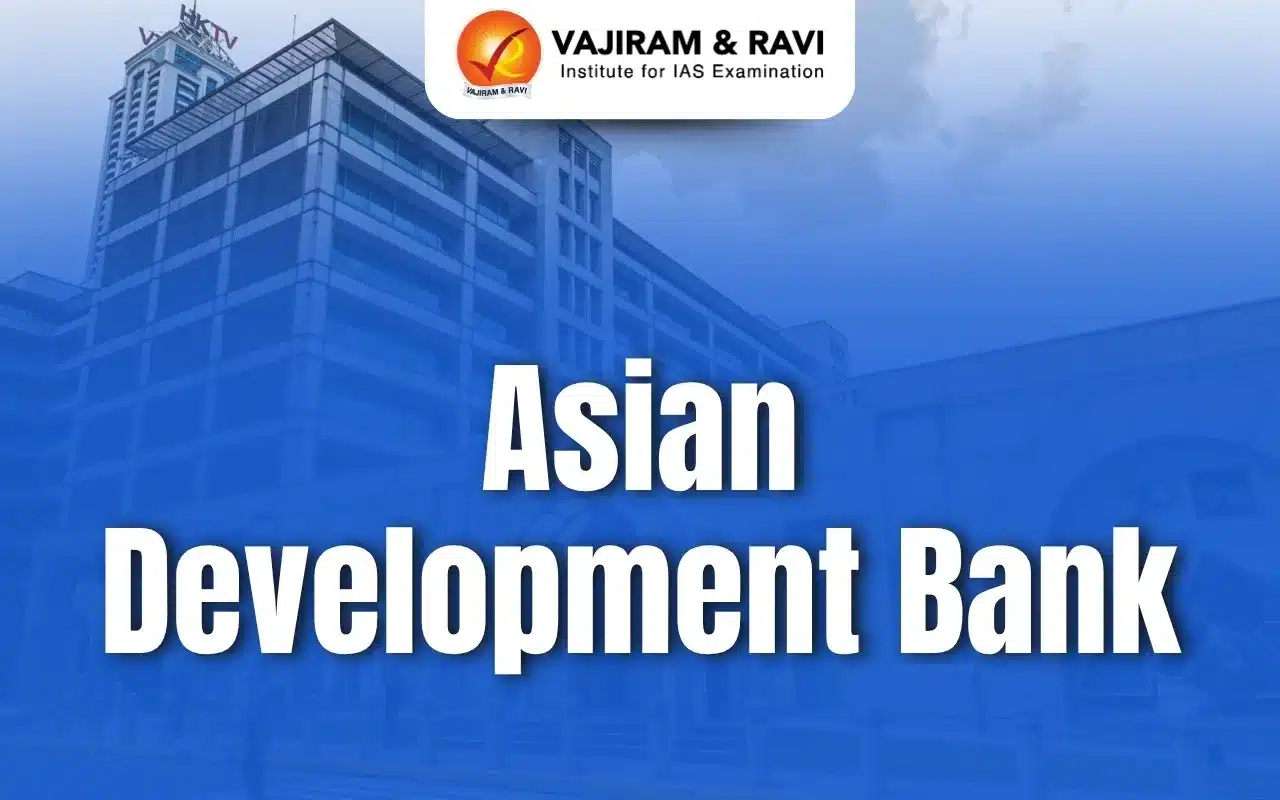Asian Development Bank Latest News
The Asian Development Bank (ADB) president recently announced a five-year initiative to transform urban infrastructure across India, with an estimated investment of $10 billion.
About Asian Development Bank
- It is a multilateral development bank established on 19th December 1966.
- It is the principal international development finance institution for the Asia-Pacific region.
- It envisions a prosperous, inclusive, resilient, and sustainable Asia and the Pacific, while sustaining its efforts to eradicate extreme poverty in the region.
- Headquarters: Manila, Philippines.
- In terms of financial commitments to members that are developing countries, India ranks first with 14% of the bank’s financial commitment, followed by China, Bangladesh, the Philippines, and Pakistan.
Asian Development Bank Functions
- It provides assistance to its developing member countries, the private sector, and public-private partnerships through grants, loans, technical assistance, and equity investments to promote social and economic development.
- ADB maximizes the development impact of its assistance by facilitating policy dialogues, providing advisory services, and mobilizing financial resources through cofinancing operations that tap official, commercial, and export credit sources.
- The Bank focuses on six key areas that align with the UN’s Sustainable Development Goals (SDGs): education, health, transport, energy, finance, and climate change.
- The ADB also works in partnership with NGOs and private companies to improve capital markets and the business infrastructure of developing countries in the region.
Asian Development Bank Membership
- Membership in the ADB is open to members and associate members of the United Nations Economic Commission for Asia and the Far East.
- It’s also open to other regional countries and non-regional developed countries that are members of the U.N. or of any of its specialized agencies.
- From 31 members at its establishment in 1966, ADB has grown to encompass 69 members, including 49 regional members from Asia and the Pacific, such as India, China, Japan, South Korea, Australia, and many others, and 20 non-regional members from Europe, North America, and other regions.
Asian Development Bank Governance
- It is operated by a Board of Governors, which is composed of one representative from each member state.
- The Board then votes to choose 12 of their members to serve as the Board of Directors, with eight members coming from members from the Asia and Pacific region and the other four from non-regional members.
- The Board of Governors is also responsible for electing a president who serves a five-year term as the chairperson of the Board as well as being responsible for the bank’s operations.
- Because Japan founded the ADB and remains the largest shareholder of the bank, every single president of the ADB has been from Japan.
Asian Development Bank Voting Power
- The ADB was modelled closely on the World Bank and has a similar weighted voting system where votes are distributed in proportion to members’ capital subscriptions.
- ADB’s five largest shareholders are Japan and the United States (each with 15.6% of total shares), the People’s Republic of China (6.4%), India (6.3%), and Australia (5.8%).
Asian Development Bank Source of Funding
- It raises capital regularly through the international bond markets.
- The ADB also relies on member contributions, retained earnings from lending, and the repayment of loans for the funding of the organization.
Asian Development Bank FAQs
Q1: Where is the headquarters of Asian Development Bank situated?
Ans: Manila, Philippines
Q2: How is voting power determined in the ADB?
Ans: Proportional to members’ capital subscriptions.
Q3: Which two countries are the largest shareholders of the ADB?
Ans: Japan and the United States
Source: FE
Last updated on December, 2025
→ Check out the latest UPSC Syllabus 2026 here.
→ Join Vajiram & Ravi’s Interview Guidance Programme for expert help to crack your final UPSC stage.
→ UPSC Mains Result 2025 is now out.
→ UPSC Notification 2026 is scheduled to be released on January 14, 2026.
→ UPSC Calendar 2026 is released on 15th May, 2025.
→ The UPSC Vacancy 2025 were released 1129, out of which 979 were for UPSC CSE and remaining 150 are for UPSC IFoS.
→ UPSC Prelims 2026 will be conducted on 24th May, 2026 & UPSC Mains 2026 will be conducted on 21st August 2026.
→ The UPSC Selection Process is of 3 stages-Prelims, Mains and Interview.
→ UPSC Result 2024 is released with latest UPSC Marksheet 2024. Check Now!
→ UPSC Prelims Result 2025 is out now for the CSE held on 25 May 2025.
→ UPSC Toppers List 2024 is released now. Shakti Dubey is UPSC AIR 1 2024 Topper.
→ UPSC Prelims Question Paper 2025 and Unofficial Prelims Answer Key 2025 are available now.
→ UPSC Mains Question Paper 2025 is out for Essay, GS 1, 2, 3 & GS 4.
→ UPSC Mains Indian Language Question Paper 2025 is now out.
→ UPSC Mains Optional Question Paper 2025 is now out.
→ Also check Best IAS Coaching in Delhi
Tags: asian development bank prelims pointers upsc current affairs upsc prelims current affairs

















